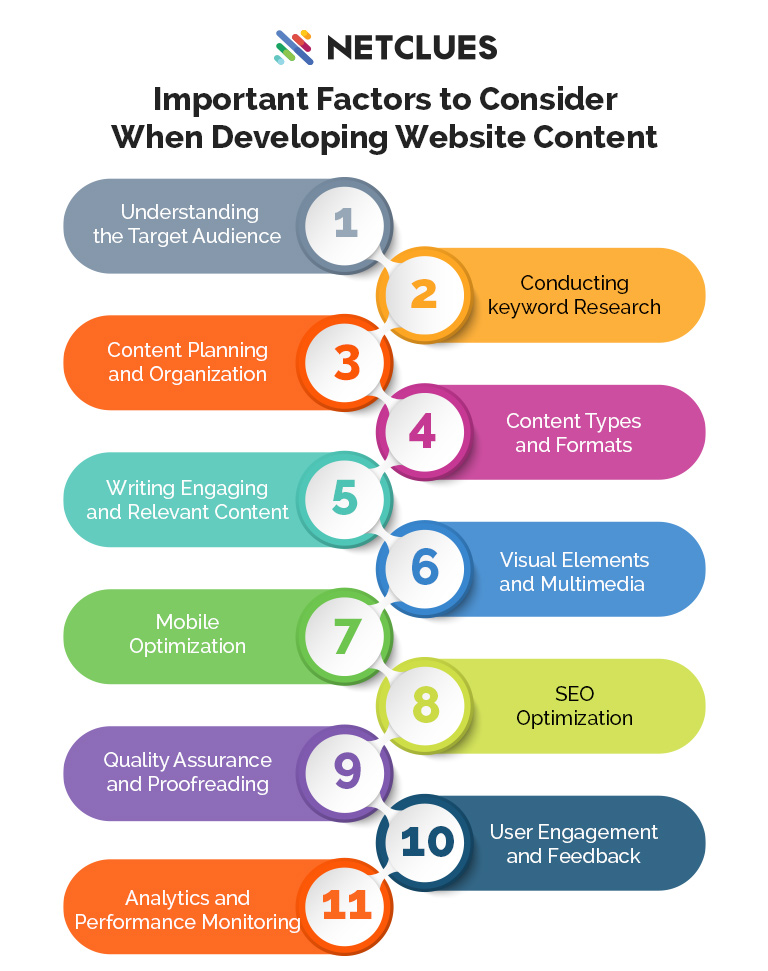
Creating website content is paramount for forging a strong digital footprint for an individual, a business, or an organization. It includes the development of the textual, visual, and interactive components that greet visitors as they navigate through a website.
For instance, an aspiring baker who established a thriving bakery is now looking to break into the online market. The transition from a traditional bakery to a formidable online presence necessitates a strategic approach to digital marketing and creating an enticing website.
Let's explore how a novice baker can break down the idea that creating content for a website is crucial for building a successful online presence.
Important Factors to Consider When Developing Website Content
Here is a thorough explanation of the actions an amateur baker can take to enter the digital world effectively:

Understanding the Target Audience
In order to create engaging content, it is essential to understand the target audience. Take the aspiring baker as an example.
By catering to individuals with an appetite for sugary treats and gourmet delights, the baker can create content suited to this specific group of people. This approach establishes a clear focus, allowing the baker to hone their marketing efforts effectively.
Anyone outside this audience becomes an incidental market, reinforcing the significance of catering to the defined target audience.
You can address their specific needs and concerns by understanding the users' pain points, interests, and preferences.
This targeted approach enhances user satisfaction and increases the likelihood of achieving your website's goals, whether it's driving sales, encouraging interaction, or sharing information.
In essence, good and user-friendly website content is built on the foundation of audience understanding.
Conducting keyword Research
Keyword research plays a pivotal role when creating website content since it enables businesses to discover what their target audience is looking for online.
A classic example would be individuals with diabetes searching for dessert options. By incorporating keywords like "sugar-free," the baker can significantly benefit. This strategic use of keywords ensures that their products appear in relevant search results, directly connecting them with potential customers seeking specific solutions.
By identifying pertinent keywords and phrases relating to the goods and services, website owners can optimize their content to match these search terms.
Improving the website's exposure and search engine rating makes users more likely to find it when they conduct relevant queries. In addition to increasing organic traffic, efficient keyword research offers insightful data about customer behavior and preferences.
Businesses can produce educational, interesting, and SEO-friendly content that resonates with their audience by incorporating these keywords naturally into it. This will increase traffic, boost conversions, and ultimately enhance the user experience on their website.
Content Planning and Organization
Before getting started with content, define the purpose of your website. A well-structured content plan helps define the website's purpose, identify the target audience, and outline the key messages.
Creating unique and engaging content related to the industry, for instance, the online bakery. You can plan and strategize content like blog posts about baking tips, recipes, or behind-the-scenes views at the bakery, which can help users connect. User engagement can also be increased by displaying the baking process and completed goods in high-quality photos and videos.
Planning and organization are crucial aspects of developing website content since they ensure that the information presented is coherent, engaging, and easy to navigate for visitors.
By organizing content effectively, information is presented in a logical sequence, making it understandable for users. It also enhances the user experience by simplifying navigation, allowing visitors to quickly find what they're looking for.
Properly planned and organized content also contributes to search engine optimization (SEO), making the website more discoverable to search engines and improving its ranking in search results.
Ultimately, a thoughtful content strategy enhances the overall usability and appeal of the website, leading to increased user engagement and satisfaction.
Content Types and Formats
A well-formed and structured website is more likely to gain viewers' attention than one with haywire information.
When developing website content, it is crucial to determine the content type and format, as they determine how information is presented and consumed, greatly impacting user experience.
The format refers to how these elements are structured and organized on the website, such as blog posts, product descriptions, or multimedia galleries. For instance, a bakery website might use high-quality images to showcase pastries, videos demonstrating baking techniques, and blog posts sharing recipes. It can engage visitors effectively by selecting appropriate content types and formats.
Textual content could be vital for explaining the bakery's history, while images are essential for displaying products. Videos can provide a more immersive experience, demonstrating baking processes, and interactive elements like recipe calculators can enhance user engagement.
Considering these aspects ensures that the website caters to diverse audience preferences, enhancing user satisfaction and driving more traffic and conversions.
Writing Engaging and Relevant Content
Writing engaging and relevant content is crucial when developing website content for several reasons.
First and foremost, engaging content captivates visitors, keeping them on your site longer and encouraging them to explore further. This can lead to increased interaction, higher retention rates, and potentially more conversions or sales.
Moreover, relevant content ensures that the information provided aligns with visitors' interests or needs, making the website more useful and trustworthy.
Tailoring content to the target audience enhances user experience, fostering a sense of connection and credibility. Additionally, search engines prioritize relevant and engaging content, which can improve the website's search engine ranking, making it more visible to potential visitors.
Visual Elements and Multimedia
In today's digital age, people often prefer visually appealing content over plain text, making it essential for websites to incorporate images, videos, infographics, and other multimedia elements.
Remember when you were scrolling to find what to eat and saw a delicious image of desserts? Wasn’t that mouth-watering? Similarly, when visual elements and multimedia are used in website content, it makes it more attractive. It helps break down complex information into digestible chunks, making it easier for users to understand and retain.
Moreover, visuals can evoke emotions and create a memorable impact, leading to increased user satisfaction and prolonged website visits.
Multimedia elements enhance accessibility, allowing information to be presented in various formats suitable for different types of users, including those with disabilities.
Therefore, integrating visual elements and multimedia makes the website more engaging and informative, ensuring inclusivity and a positive user experience.
Mobile Optimization
Imagine opening your desired website on your phone only to discover it isn't compatible with smartphones. Annoying, isn’t it?
In this digital world, mobile optimization is important when developing website content due to the widespread use of smartphones and tablets for internet browsing.
With significant web traffic from mobile devices, ensuring your website is optimized for smaller screens and touch interactions is essential. It enhances user experience by providing seamless navigation and faster loading times.
It positively impacts rankings, as search engines like Google prioritize mobile-friendly websites. Failing to optimize for mobile can result in frustrated users, high bounce rates, and lost opportunities for engagement and conversions.
Therefore, mobile optimization during website content development is paramount to reaching and retaining a larger audience, improving user satisfaction, and achieving online success.
SEO Optimization
For several reasons, SEO (Search Engine Optimization) optimization is crucial when developing website content.
Firstly, it ensures that your website ranks higher in search engine results pages, making it more visible to users searching for relevant information or products/services.
By incorporating relevant keywords, optimizing meta tags, and creating high-quality content, you increase the likelihood of search engines recognizing your site as valuable and trustworthy, thus improving its ranking.
Secondly, an SEO company enhances user experience by making the website more accessible and easy to navigate, which can reduce bounce rates and increase the time visitors spend on your site.
Thirdly, it helps reach your target audience effectively, as optimized content is more likely to match the search queries of your potential customers.
Ultimately, integrating SEO strategies into your website content development process is essential for driving organic traffic, increasing SEO ranking, and ensuring the overall success of your online presence.
Quality Assurance and Proofreading
Quality Assurance and Proofreading are crucial aspects to consider when developing website content. It ensures that the content is accurate, consistent, and aligns with the intended message and branding of the website.
It involves checking for grammatical errors, formatting issues, and broken links to enhance the user experience.
On the other hand, proofreading focuses on meticulously examining the content to identify and correct spelling, grammar, and punctuation errors, ensuring the content is polished and professional.
Both processes are essential for maintaining the website's credibility, enhancing user trust, and conveying information effectively.
Error-free content reflects the website's professionalism and contributes significantly to user engagement and success.
User Engagement and Feedback
User engagement refers to the interaction and involvement of visitors with the content, while feedback represents the opinions and responses of the users about the website's content and functionality.
Understanding user engagement helps writers create content that resonates with the audience, making the website more appealing and user-friendly.
By analyzing feedback, developers gain valuable insights into user preferences and pain points, enabling them to make necessary improvements. This iterative process ensures the website is tailored to meet users' needs, enhancing their experience and increasing overall satisfaction.
By incorporating user engagement and feedback, a renowned website development company can create a more effective and user-centered website that attracts, retains, and satisfies visitors, ultimately contributing to the site's success and relevance in the digital landscape.
Analytics and Performance Monitoring
After developing the website content, wouldn’t you want to know how it performs? Analytics and performance monitoring help in multiple ways.
Firstly, analytics tools provide valuable insights into user behavior, such as which pages are popular, how long visitors stay, and what content they engage with the most. This data helps understand audience preferences, enabling content creators to effectively tailor their material to meet user needs and interests.
Secondly, performance monitoring focuses on the website's speed, responsiveness, and overall user experience. A slow or poorly performing website can drive visitors away, negatively impacting user engagement and conversion rates.
By tracking performance metrics, developers can optimize the site for faster loading times and smoother navigation, ensuring a positive user experience.
Integrating analytics and performance monitoring into content development allows businesses to create a user-friendly, engaging website that meets user expectations and business goals. This leads to increased traffic, higher retention rates, and improved conversion rates.
Conclusion
Creating quality website content is essential for developing a strong online presence, whether for an individual, a company, or an organization. In-depth keyword research, careful planning & organization of content, choosing suitable content types and formats, and developing interesting, pertinent content are all steps in this process.
Enhancing user experience and online exposure requires integrating multimedia and visual components, optimizing for mobile devices, and implementing an SEO roadmap.
Quality assurance, user engagement, and feedback analysis ensure credibility and user satisfaction, while analytics and performance monitoring provide valuable insights for continuous improvement.





